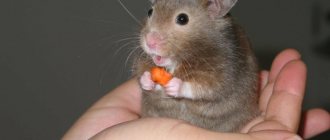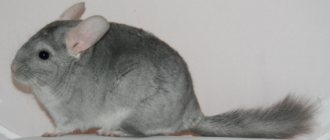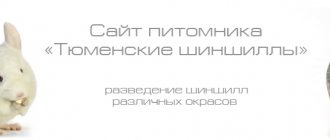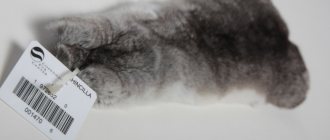Many believe that chinchilla breeds are fiction, and that the animals can be exclusively gray, the way they are most often seen in pet store windows and in photos on the Internet. However, this opinion is wrong. Breeders have been working for decades to ensure that the breeds and shades of these funny rodents only increase.
Below we will introduce you to the varieties of chinchilla colors and their breeds offered in nurseries.
Chinchilla breeds
These domesticated rodents are divided into two varieties, which have their own characteristics in the structure of the body and the length of the tail:
- Large short-tailed Peruvian chinchillas came to us from Bolivia and Argentina. These places are their homeland, and there they live in the wild, but only in protected areas, since local residents exterminate them for their valuable fur. In addition to nature reserves, they are also grown on specialized farms. Short-tailed chinchillas not only have dense fluffy fur, but also a fairly strong body. Standing on its hind legs, the animal reaches a height of up to 40 centimeters and weighs about 800 grams. The tail of large rodents is short, covered with stiff, short hair.
- Coast long-tailed chinchillas are common in Chile. They have a small body and a long tail covered with dense fur. Their weight does not exceed 700 grams.
Both chinchilla breeds are light gray in color. However, thanks to the efforts of breeders, long-tailed chinchilla rodents can now boast a huge variety of shades of their magnificent skin.
Angora chinchilla
One of the subspecies of long-tailed animals is the Angora royal chinchilla. It was not bred artificially. The rodent appeared thanks to the efforts of nature itself.
The animal was first noticed in the sixties of the last century. But he was included in the breed directory only in 2001. It is extremely difficult to breed this subspecies in artificial conditions, since the children from the male and female of this breed of chinchillas do not always turn out to have long hair; they often have short hair. It is for this reason that breeding Angora dogs requires the breeder not only to be professional, but also to carefully select pairs.
Angoras have silky long fur and a luxurious tail. In addition, they have long hair on their heads and paws. This breed of chinchilla has a flattened muzzle, which is why people call them Persian. The animals themselves are black, blue, diamond and purple.
“Angora chinchillas are the most expensive of all. The price of one individual is over 50 thousand rubles. The domestic animal has such valuable fur that the high cost of rodents has remained so for decades.”
Dwarf chinchilla
Mini chinchillas are also a natural genetic mutation. These animals have a small body, short legs and a bushy tail. The weight of rodents does not exceed 300 grams.
Dwarf domestic chinchillas give birth to the same cubs as their ordinary counterparts, so childbirth is difficult to endure. In most cases, babies do not survive. The animal must be under the supervision of a veterinarian throughout pregnancy. The shades of these cute animals can be different.
Varieties of colors
Since chinchillas have a lot of enemies in the wild, for their own safety, rodents have a light gray color, inconspicuous among rocky terrain.
Gray is the standard color for these cute animals, but artificially bred chinchilla breeds come in a wide variety of shades. Among them there are black, beige, white and even blue tones of chinchilla fur. Therefore, it is now extremely difficult to imagine that chinchillas originally had only gray colors.
All shades of chinchilla fur can be grouped as follows:
- gray or agouti: two shades that are standard;
- white, having different saturation and an admixture of beige and pinkish;
- brown or pastel, available in a full range of colors up to dark chocolate;
- black with varying degrees of saturation;
- purple, pink and sapphire.
In addition, it should be taken into account that fur colors differ not only in color, but also in:
- recessive. When a chinchilla is only a carrier of the gene responsible for the shade of its coat.
- dominant. When the color is already there and visible from birth.
When breeding rodents, it is extremely important to know what recessive color the male chinchilla and the female selected for mating have.
Rodents with gray color
Gray standard
Gray chinchillas are found both in the wild and in captivity.
Breeders divide them according to the color itself and its depth. Gray chinchillas are:
- light gray;
- medium gray;
- dark;
- moderately dark;
- extra dark.
Gray coloring is standard for chinchillas living in the wild and in domestic environments. The back of rodents is dark, the sides are light, and the belly is white. The wool has two shades. It is gray-blue at the base and black at the ends of the hairs.
Individuals of gray shades, unlike other rodents, are distinguished by very good health. In addition, the age of chinchillas of this shade to bear their first offspring is much lower than that of other subspecies. They can be crossed with absolutely any variety. Rodents have fur that is delicate and soft to the touch.
Light gray
Light gray fur with a silver tint looks very impressive. These chinchillas have a light chest, belly and limbs.
Medium gray
The most common color. The body of the animals has a uniform gray tint, the fur on the stomach, limbs and chest is light.
Dark
The fur has a gray tint with a bluish tint. The belly and chest of rodents are light, standing out well against the background of the rest of the fur.
Moderately dark
The fur of rodents has a dark gray tint, turning into ashy on the face, limbs and sides. Chinchillas have a bluish-white belly.
Extra dark
Many breeders prefer charcoal gray chinchillas with light sides and chest. The belly of this subspecies of rodents is almost white.
Chinchillas with light colored fur
Chinchillas with a white coat simply look luxurious and elegant. They have a number of unusual shades.
White Wilson
Chinchillas have white fur mixed with white or beige. You can purchase such an animal at a nursery or from breeders at home. The color is in demand among connoisseurs of these rodents.
Albino
These chinchillas do not have color pigments at the genetic level, so they have a snow-white tint and a red iris.
White lova
Chinchillas have white fur with a slight cream tint and dark ruby eyes.
White velvet
These animals have light fur that is velvety to the touch. Boy chinchillas often have a silver tint, while girls have a beige tint. In addition, they have distinctive gray spots on the head and limbs.
White-pink
The description of these chinchillas is as follows. Animals with milky white fur, pinkish ears and beady black eyes. However, there are representatives of this species that have a pink stripe on the back.
Selection of black velvet chinchillas
It was the selection of this color that Gunning took up. After some time, when selecting the best dark pairs, he managed to breed animals in which the dark color had already spread through the neck to the entire back. As a result, only the stripe on the abdomen remained light in the animals.
By 1960, a new mutation of chinchillas was introduced to the world - black velvet. At that time it was called gunning black velvet. It is this color variation of the black velvet chinchilla that we see in our time.
Animals with beige fur
The main shade of these rodents is pastel. However, it has several variations. Additionally, the older the chinchilla, the darker its fur will be. It can be brown, red or beige. This type of rodent can be crossed.
Homobeige
This species of rodent has light beige fur with uniform coloring and pink ears. For this shade, single dark hairs are acceptable.
Heterobeige
In these rodents, on the contrary, the color is uneven. The entire coat is beige, and the undercoat and ends of the hairs are brown. When choosing a chinchilla, you should pay attention to the color distinction between the rest of the body and the belly.
Beige tower
The color of the fur of these animals varies from light to dark beige, which is combined with a brown pattern located along the spine.
Wellman beige
The chinchilla has light beige fur, light ears and dark eyes.
Beige Sullivan
Rodents have rich beige fur and red eyes.
Brown velvet
The basic fur color of these animals is beige, while the back and head have a chocolate tint, and the belly is sandy.
Crossbreeding
This breed of pet is often crossed with other breeds in order to improve color. Black Velvet puppies are lighter in color at birth, but as they mature, their fur becomes a darker, richer shade.
By crossing black chinchillas with other colors, you can get different shade variations. Here are the most common variations that are obtained by crossing different pets.
| Color | Possible offspring |
| Black velvet + gray standard | Black or standard |
| Black velvet + beige | Standard, beige, black velvet or brown |
| Black velvet + homobeige | Beige, brown velvet |
| Black velvet + white | Standard, white, black or white velvet |
| Black velvet+white-pink | Black velvet. Brown, white or white-pink. Beige, white, standard |
Chinchilla ebony
These animals are distinguished not by a certain color, but by the quality of their skin. If you bring the rodent to the light, the fur begins to shine and shimmer. The color palette of such chinchillas is quite diverse.
Homoebony
Chinchillas of this color have black fur and black eyes. Also, the color of these animals has a second name - charcoal.
Heteroebony
These rodents combine two shades: black and gray. They are very impressive and often take first place at exhibitions.
White ebony
Chinchillas have snow-white fur with a black coating at the ends of the hairs. The limbs, head and base of the tail may have a beige tint.
Description and characteristics
Chinchilla Black Velvet has the following characteristic features:
- animals have heterozygous color (dominant dark gene and retreating);
- on the muzzle there is a dark mask with clear boundaries;
- there are distinct dark diagonal stripes on the paws;
- fur of rich charcoal color;
- round muzzle;
- paws are wide;
- crook in the nose;
- belly white;
- there is a white edging around the ears;
- dense bones.
Chinchillas with dark fur
These rodents include black velvet chinchillas with rich black fur and a white belly.
Black velvet
This color combines black and white. The animals have a black body and tail, and a white belly. This contrast looks very impressive and the clearer the color boundaries, the higher the price of a chinchilla and the more valued the breed is.
This species of rodent was bred in the 60s of the last century. Breeders believe that the dark skin is evidence of the high quality of the breed. Chinchillas may have light stripes on their limbs, a charcoal mask, and dark fur on their heads.
The older a rodent gets, the more pronounced its breed characteristics become. Since the black fur gene is lethal, crossing with representatives of your own breed is unacceptable; black chinchillas can only be mated with rodents of other colors.
Choice when purchasing
Choosing the right animal at the time of purchase is the key to success in the future.
Did you know? Despite their fatness, furry rodents can fit into very narrow crevices due to the ability of their skeletons to compress vertically.
The main criteria that you should first pay attention to include:
- appearance of the animal - a healthy chinchilla should have a clean nose and eyes without any discharge, yellow, even and clean teeth, ears without ulcers or wounds, thick, shiny, even, clean fur, a tail pointing upward, without remains of feces, the body is elastic;
- rodent behavior - despite the fact that chinchillas can be different in behavior (active, calm), normally the animal should look well-fed, not lethargic, without signs of disease;
- It is recommended to buy an animal from trusted sellers-breeders (not preferably at the market or in a pet store), who provide its pedigree, know everything about their pet (what it eats, when and how much, what vaccinations have been given, its character, preferences, etc.) , professionally and specifically tell you how to further care for him, leave your contact information if necessary;
- It is not advisable to purchase a rodent based on advertisements from the Internet or other information sources; you need to see it with your own eyes in order to buy a healthy animal;
- It is not recommended to buy animals at reduced prices, because their cost ranges from 6 thousand rubles and more;
- animals weighing up to 200 g may not survive in new habitats.
Rare colors of chinchillas
The most expensive and valuable animals have a rare, very beautiful color. Breeders managed to breed several breeds, looking at which it is simply impossible to contain delight.
Violet
Rodents have a light lilac coat, contrasting with a white belly. The ears and nose of the animals have a purple tint. When crossed, the unusual color is passed on only in the first and second generations. Purple chinchillas mature late and can mate only after one and a half years.
Sapphire
The fur of these animals can be either bluish-gray or light blue with a light graphite coating. Chinchillas have a white belly and black eyes. The animals are among the most expensive and sought after among breeders. The unique coloring does not appear immediately, but only by 8 months. To purchase a real sapphire chinchilla, it is better to purchase the rodent from a licensed nursery.
Blue Diamond
Chinchillas have light blue fur with a metallic sheen. There is a dark stripe along the ridge and head.
White and pink diamond
One of the rare colors is pearl with a pinkish tint. The color of such chinchillas' fur resembles pearls. The exception is the ears, which have a pinkish tint. The pearl gene is lethal, so representatives of the same breed cannot be crossed. Chinchillas of other colors are suitable for mating.
Colors
Color is the main difference between chinchillas of different breeds. In this regard, the breeders have done a very good job. Therefore, now on the zoological market you can find fluffies of a wide variety of colors. All chinchillas, depending on color, are divided into several large groups:
- standard;
- beige;
- white fur;
- ebony;
- dark color.
Also among chinchillas there are individuals with fur of very rare interesting colors. For example, blue diamond, purple, sapphire, white and pink diamond.
In nature, only inconspicuous gray chinchillas are found. They may not look so attractive, but they are reliably protected from enemies. With the help of a gray fur coat, fluffies successfully blend into evening and night landscapes.
Breeding chinchillas
Thanks to the wide variety of rodent colors, breeders have plenty of opportunities to develop new breeds. Crossbreeding itself is a unique process, because you never know whether the babies may display a recessive gene from one of the parents. However, there are also restrictions on mating individuals. For example, there are two lethal genes: black and white. They cannot be combined, otherwise not only the babies, but also the female herself may die while carrying them.
"Note! To carry out successful crossbreeding, all breeders have passports for their animals. The documents indicate what genes their pets have, and also indicate the possible color of their future babies.”
Results
Breeding chinchillas is a very profitable business. However, in order to become an experienced breeder, you should take into account not only the breeds of chinchillas and their colors, but also know all the intricacies of the care and nutrition of these magnificent animals.
Gray and beige rodents are easier to breed, they are more common, and their babies are cheaper than, for example, sapphire and purple ones. Crossing and breeding chinchillas is an extremely complex process, so it needs to be approached wisely and only done by those people who are truly interested in it. You should not do this for the sake of banal profit, since nothing good will come from such a business.
Not only breeders, but also scientists around the world are engaged in breeding new breeds. They are driven to this by the popularity of rodents not only as pets, but also by their breeding as specimens to obtain valuable fur.
Keeping a chinchilla at home is not very easy, but it is worth it. The animals love their owners very much and treat them with tenderness and love. Breeders advise purchasing chinchillas in pairs, because there is nothing more pleasant than watching their games, affection, love and friendship, which a person can only envy.











